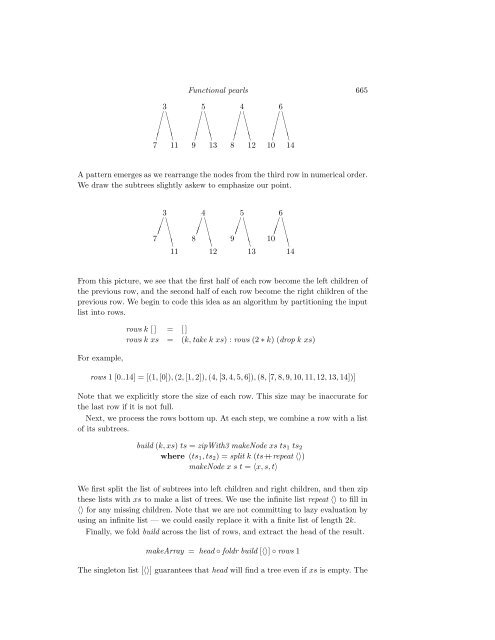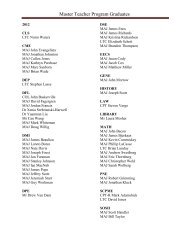FUNCTIONAL PEARLS Three Algorithms on Braun Trees - West Point
FUNCTIONAL PEARLS Three Algorithms on Braun Trees - West Point
FUNCTIONAL PEARLS Three Algorithms on Braun Trees - West Point
Create successful ePaper yourself
Turn your PDF publications into a flip-book with our unique Google optimized e-Paper software.
Functi<strong>on</strong>al pearls 665<br />
3 5 4 6<br />
✄ ❈<br />
✄ ❈❈❈<br />
✄<br />
✄<br />
7 11<br />
✄ ❈<br />
✄ ❈❈❈<br />
✄<br />
✄<br />
9 13<br />
✄ ❈<br />
✄ ❈❈❈<br />
✄<br />
✄<br />
8 12<br />
✄ ❈<br />
✄ ❈❈❈<br />
✄<br />
✄<br />
10 14<br />
A pattern emergesas we rearrangethe nodes from the third row in numerical order.<br />
We draw the subtrees slightly askew to emphasize our point.<br />
3 4 5 6<br />
✂ ❈<br />
✂✂ ❈❈❈<br />
7<br />
✂ ❈<br />
✂✂ ❈❈❈<br />
8<br />
✂ ❈<br />
✂✂ ❈❈❈<br />
9<br />
✂ ❈<br />
✂✂ ❈❈❈<br />
10<br />
11 12 13 14<br />
From this picture, we see that the first half of each row become the left children of<br />
the previous row, and the sec<strong>on</strong>d half of each row become the right children of the<br />
previous row. We begin to code this idea as an algorithm by partiti<strong>on</strong>ing the input<br />
list into rows.<br />
For example,<br />
rows k [] = []<br />
rows k xs = (k,take k xs) : rows (2∗k) (drop k xs)<br />
rows 1 [0..14] = [(1,[0]),(2,[1,2]),(4,[3,4,5,6]),(8,[7,8,9,10,11,12,13,14])]<br />
Note that we explicitly store the size of each row. This size may be inaccurate for<br />
the last row if it is not full.<br />
Next, we process the rows bottom up. At each step, we combine a row with a list<br />
of its subtrees.<br />
build (k,xs) ts = zipWith3 makeNode xs ts1 ts2<br />
where (ts1,ts2) = split k (ts++repeat 〈〉)<br />
makeNode x s t = 〈x,s,t〉<br />
We first split the list of subtrees into left children and right children, and then zip<br />
these lists with xs to make a list of trees. We use the infinite list repeat 〈〉 to fill in<br />
〈〉 for any missing children. Note that we are not committing to lazy evaluati<strong>on</strong> by<br />
using an infinite list — we could easily replace it with a finite list of length 2k.<br />
Finally, we fold build across the list of rows, and extract the head of the result.<br />
makeArray = head◦foldr build [〈〉]◦rows 1<br />
The singlet<strong>on</strong> list [〈〉] guarantees that head will find a tree even if xs is empty. The




